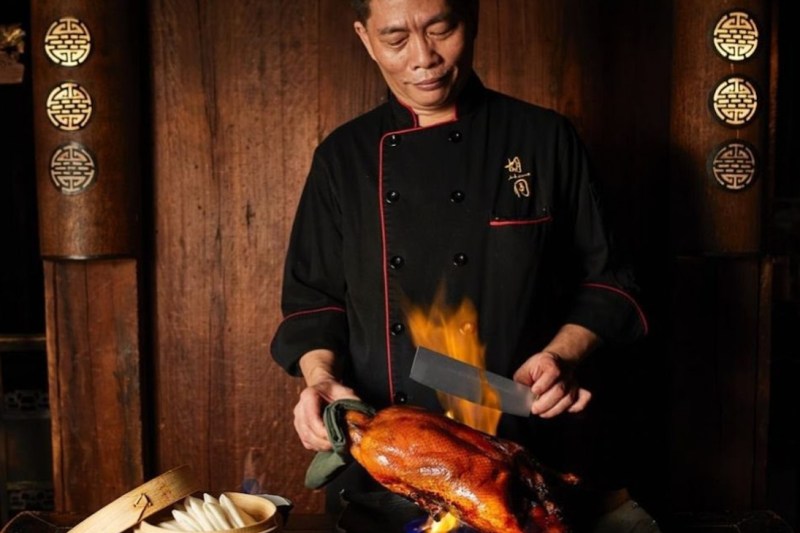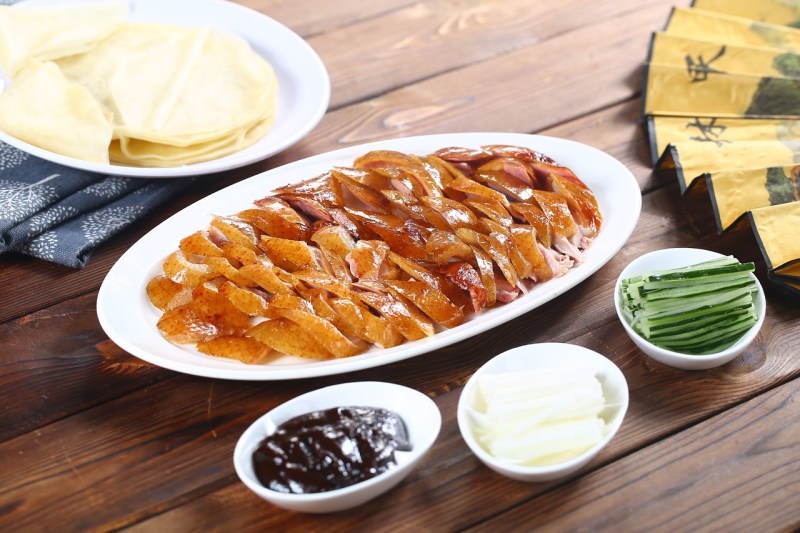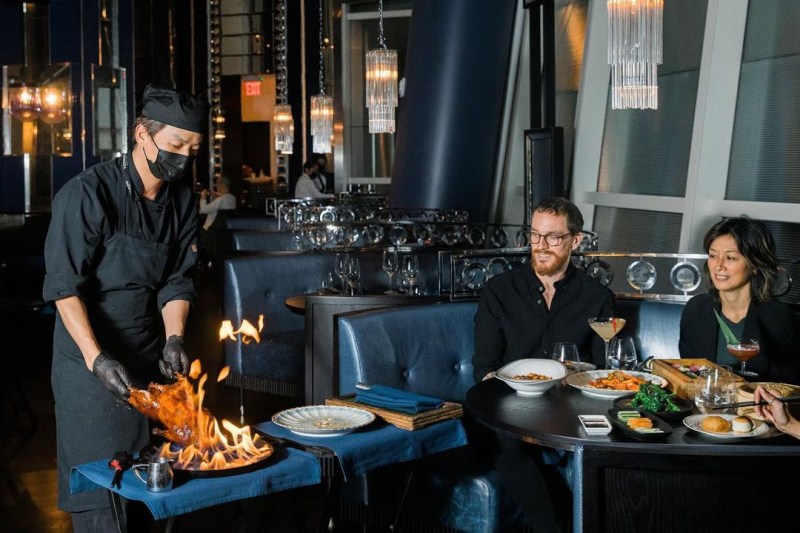
When President Richard Nixon visited China on a historic diplomatic trip in 1972, the Chinese government welcomed him with a lavish dinner party. Throughout the extravagant feast of seafood and Chinese delicacies, there was one item that Nixon famously described as his favorite — Peking Duck. It’s no accident that Peking Duck was served as part of a celebratory meal for honored guests. Peking Duck is not a straightforward dish of simple, roasted duck. Instead, it’s a complex, historical dish that’s often the centerpiece of Chinese cuisine.
For such a complex dish with a rich culinary history, it can come as a surprise that Peking Duck innovation is still occurring today. At Hutong in New York City, a fine-dining Chinese restaurant with additional locations in London, Hong Kong, and Dubai, tradition has melded seamlessly with innovation to create a unique style of flaming Peking Duck.
Traditional Peking Duck

Despite the name, the history of Peking (Beijing) Duck actually traces its origins to 13th-century Hangzhou, China. Roast duck was a staple in this area of China, including Nanjing, the capital of the Ming Dynasty and a city famous for its duck dishes. However, it wasn’t until 1420, when the imperial capital was moved to Beijing, that this style of roast duck became associated with the city. Eventually, Peking Duck chefs in Beijing began to breed their own ducks for roasting. This duck breed, famous for its pure white feathers and thin skin, is the ideal bird for Peking Duck.
Making traditional Peking Duck is a very time-consuming process. Of utmost priority is producing duck with incredibly crisp skin, which most connoisseurs consider more important than the meat itself. To achieve this, an air pump is inserted underneath the skin of the whole duck to separate the skin from the meat. This technique allows the fat to render properly during roasting, and also creates a plump appearance to the roasted bird. The organs are also removed in a distinctive way — a slit is cut under one wing, allowing the innards to be removed. This is to ensure that the skin stays as intact as possible on the whole duck. The skin is also tightened with hot water before being air-dried and brushed with maltose syrup (for color). The bird is then attached by the neck to a metal hook and roasted in a hanging wood fire oven. Traditionally, fruit woods like apples or jujube are used for roasting.
Along with other styles of Chinese duck, such as Cantonese roast duck, the act of serving Peking Duck is an intricate process. A long, thin blade, called a pianya dao is used to carve the duck table-side. An experienced Peking Duck chef can carve a whole duck into 100 pieces. The skin is usually eaten first with a bit of white sugar. While the duck pieces can be eaten as is, Peking Duck is always accompanied by an array of thin, steamed pancakes, sliced white leeks, cucumber, and sweet hoisin sauce.
Hutong’s Innovative Flaming Duck
At Hutong, they’ve taken the Peking Duck and added some innovative twists to tradition. Hutong is all about Chinese fine dining and the menu is filled with elegant dim sum dishes, carefully curated seafood, and an extensive wine list. Besides using different seasonings and sauces for their duck, Hutong has also decided to flame the duck table-side, giving their Peking Duck a bonus level of crisp skin. This innovation is courtesy of Hutong’s Head of Barbecue, Chef Martin Mak, a culinary professional with over 50 years of experience.
For the New York location of Hutong, they source their ducks from Joe Jurgielewicz & Son, Ltd., a family-owned Pennsylvania farm and one of the largest Pekin duck (Pekin is the type of duck commonly used for Peking Duck) suppliers in North America. At Joe Jurgielewicz & Son, the ducks roam free in large temperature-controlled barns and are fed a strict diet of corn and soybeans. Before the ducks are even seasoned and cooked, Hutong air-dries them for 36 hours. The seasoning for Hutong’s Peking Duck is different than the traditional recipe. At Hutong, they season their duck with a variety of spices including Sichuan peppercorns and green chilies, black peppers, rosemary, star anise, and Hutong’s homemade chili paste.
Although it’s served with the traditional, steamed pancakes, the accompanying sauces at Hutong are distinct. Besides hoisin, there’s also Hutong’s in-house mustard, sliced strips of sweet cantaloupe and papaya along with traditional cucumber and spring onions. While the meat and skin is delicious by themselves, the variety of sauces and ingredients gives Hutong’s duck an interesting diversity in flavor that accentuates the Peking Duck experience.
Finally, there’s the star attraction, the table-side flaming. First, the duck is presented table-side by a skilled carver before the whole bird is set completely on fire. The flames are achieved with the help of Chinese rose wine and rum, giving the duck an excellent fragrance when combined with the chilies and spices of the roasted duck. The entire process, flames and all, occurs in full view of diners. The sight and smell of whole, flaming duck is an experience that’s hard to beat at any restaurant. After the duck is then carved in classic Peking Duck fashion, and the carcass is taken back to the kitchen, where Hutong will cook some of the leftover meat in a stir fry, served with crisp lettuce cups as a second course.
Currently, the flaming Peking duck is only available Monday through Thursday for 5 reservations an evening at the New York location (although it’s also available for special events and in the private dining room). This is truly a Peking Duck experience that’s one of a kind.
Editors' Recommendations
- Birth of Nobu – Luxury Hotel and Restaurant Chain Robert De Niro Helped Start
- Meet the Chef Who Is Changing Korean Fine Dining in America
- Chris Marshall’s No-Alc Sans Bar is All Hangout and No Hangover
- How To Throw a Winning Brunch Party, According to Chef Chris Valdes
- Celebrity Chef Ming Tsai Is Fighting Asian Hate Crimes





